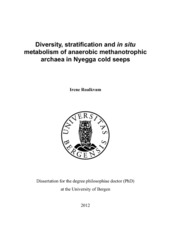| dc.contributor.author | Roalkvam, Irene | eng |
| dc.date.accessioned | 2012-08-20T07:53:22Z | |
| dc.date.available | 2012-08-20T07:53:22Z | |
| dc.date.issued | 2012-06-08 | eng |
| dc.identifier.isbn | 978-82-308-2059-9 | en_US |
| dc.identifier.uri | http://hdl.handle.net/1956/5956 | |
| dc.description.abstract | Anaerobic methanotrophic Archaea (ANME) have considerable importance in a global environmental context as they are considered the major biological sink for methane due to their ubiquitous distribution in anaerobic methaneenriched sediments world-wide. Together with a sulfate-reducing partner, ANME perform anaerobic oxidation of methane (AOM) coupled to sulfate reduction. Knowledge about the syntrophic lifestyle, adaptations to varying geochemical conditions and the biochemistry of these uncultivated archaea is limited. In this study, the microbial communities were sampled from sediment cores that were retrieved from two locations at the Nyegga cold seep area. The cores were sampled inside the G11 pockmark and at the CN03 area, which are characterized by differences in the methane fluid flux. The parallel pyrosequencing of 16S rRNA gene amplicons provided taxonomic information with high resolution for analyses of the microbial communities. New information about the vertical transition of ANME clades in sediments, as well as information about their co-occurring microbial assemblages was obtained. While the dominating ANME-1 population was observed as free-living cells in chains, high abundances of either Deltaproteobacteria and Candidate division JS-1, or Deep Sea Archaeal Group (DSAG) and Marine Group 1 (MG-1) were found in ANME-2 dominated horizons in the cores. The ANME-2a/b population seemed most sensitive to elevated sulfide concentrations, and the presence of different dominating ecotypes of ANME-2a/b at the two locations could indicate adaptations to the site-specific geochemical conditions. The free-living ANME-1 clade, tolerating elevated sulfide concentration, accounted for up to 89.2% of the retrieved 16S rRNA gene sequences in the sediment core sampled inside the G11 pockmark. A coupled metagenomic and metaproteomic approach was developed to study the in situ metabolism of this microbial community. Pyrosequencing of the total DNA resulted in 16.6 Mbp of sequence information that was assembled into contigs and subsequently used as a custom database, in addition to the publically available ANME sequence information, for protein identification. The results showed that the enzymes in the reverse methanogenesis pathway (except methylene tetrahydromethanopterin reductase), associated electron-accepting complexes, and proteins possibly involved in cold adaptations and production of gas vesicles were expressed by ANME-1. In addition, a novel adenylylsuflate (APS) reductase, affiliated with a Gram-positive sulfate reducing bacteria (SRB) was identified. Overall, the results challenge the hypothesis of an obligate syntrophy with SRB for ANME-1. Future studies are needed to reveal if the free-living ANME-1 is both a methanotrophic and a sulfatereducing archaeon that completes the process of AOM itself. However, the coupled metagenomic and metaproteomic approach was effective in assessing the major in situ metabolic processes in the cold seep sediments. | en_US |
| dc.language.iso | eng | eng |
| dc.publisher | The University of Bergen | en_US |
| dc.relation.haspart | Paper I: Roalkvam, I., Jørgensen, S. L., Chen, Y., Stokke, R., Dahle, H., Hocking, W. P., Lanzén, A., Haflidason, H. & Steen, I. New insights into stratification of anaerobic methanotrophs in cold seep sediments. FEMS Microbiology Ecology 78(2): 233–243, November 2011. Full text not available in BORA due to publisher restrictions. The article is available at: <a href="http://dx.doi.org/10.1111/j.1574-6941.2011.01153.x" target="blank"> http://dx.doi.org/10.1111/j.1574-6941.2011.01153.x</a> | en_US |
| dc.relation.haspart | Paper II: Stokke, R., Roalkvam, I., Lanzén, A., Haflidason, H. & Steen, I. Integrated metagenomic and metaproteomic analyses of an ANME-1 dominated community in marine cold-seep sediments. Environmental Microbiology 14(5): 1333 –1346, May 2012. Full text not available in BORA due to publisher restrictions. The article is available at: <a href="http://dx.doi.org/10.1111/j.1462-2920.2012.02716.x" target="blank"> http://dx.doi.org/10.1111/j.1462-2920.2012.02716.x</a> | en_US |
| dc.relation.haspart | Paper III: Roalkvam, I., Dahle, H., Chen, Y., Jørgensen, S. L., Haflidason, H. & Steen, I. Fine-scale community structure analysis of ANME in Nyegga sediments with high and low methane flux. Full text not available in BORA. | en_US |
| dc.title | Diversity, stratification and in situ metabolism of anaerobic methanotrophic archaea in Nyegga cold seeps | en_US |
| dc.type | Doctoral thesis | |
| dc.rights.holder | Copyright the author. All rights reserved | en_US |
| dc.subject.nsi | VDP::Mathematics and natural science: 400::Basic biosciences: 470 | en_US |
